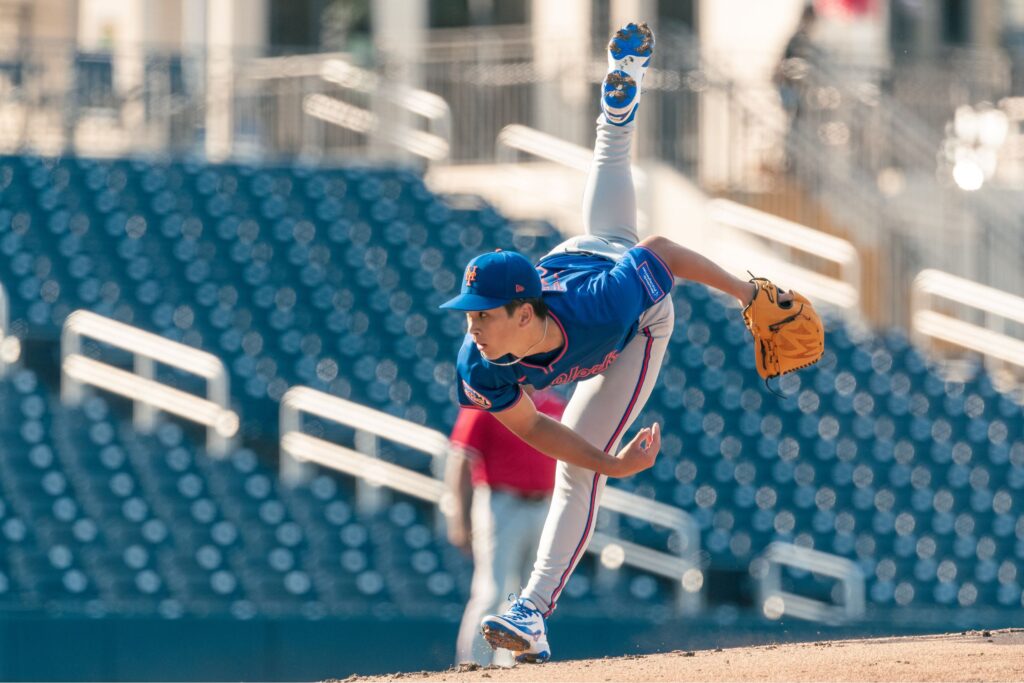Every Monday morning, we highlight 10 players who stood out to us based on their underlying Statcast metrics. Data will usually be through Saturday of that week, but may include some data from Sunday games. These are not full scouting reports, but often serve as good early indicators of prospects who might be ready to break out or are demonstrating MLB-ready skills.
Last week, we marveled at the emergence of three pitchers who are suddenly wielding arsenals filled with plus pitches, with a deep dive on Trey Gibson and Payton Tolle. This week we’ll discuss:
10 Statcast Standouts
Jonah Tong, RHP, Mets
Writing about prospects is an effort to get more things correct than wrong. Every once in a while, an analysis or prediction looks particularly good in hindsight. This is not to say that I possess some magical soothsaying prescience with respect to prospects—I don’t. However, every once in a while, the data for a particular prospect will jump out to me, and I can’t help but say “wow.”
Last year, Tong was one of those players. He featured in this series in late April, as his fastball had unicorn traits with elite vertical ride. I was so enthused, I went a tad hyperbolic, and gave this fantasy baseball tip to a buddy:
After doing my deep dive on his arsenal, I was so blown away, I made the following hot take:
🔥 Take: Jonah Tong is the 4th best pitching prospect in baseball after Skenes/Jobe/Painter. If the velo ticks up as he matures, he might just be the best pitching prospect in baseball. He also pitches well below his max, so I have fewer concerns about his long term health.
— Eli Ben-Porat 🇨🇦 (@EliBenPorat) April 28, 2024
Tong is a super pronator with an elite vertical fastball. This archetype is usually a four-pitch pitcher—fastball, change, slider and curve—similar in nature to guys like Jared Jones, Jack Leiter and Bubba Chandler.
Here’s what Tong’s arsenal looked like last year:
Tong was flashing the four pitches, but the changeup needed work. The dream was that he would add a couple of ticks to the fastball and turn it into an elite pitch. Fast forward to 2025, and Tong has both improved his changeup dramatically and added significant velocity to his fastball.
It’s easy to spot the difference in the two pitches. The fastball went from 93 to 96 mph and shows elite vertical ride. The changeup now gets solid depth and run with over 12 inches of vertical separation from the fastball.
So, just how good is Tong’s fastball? It might just be the closest thing to Spencer Strider’s 2023 fastball:
MetricJonah TongSpencer Strider 2023Release Height6.0 feet5.9 feetRelease Side2.3 feet2.0 feetRelease Extension6.9 feet7.0 feetVelocity95.7 mph97.2 mphVertical Break18.3 inches18.0 inchesVertical Break per 0.4 seconds18.8 inches18.8 inchesHorizontal Break3.9 inches5.9 inchesSpin Rate2,297 rpm2,362 rpm
Tong and Strider essentially have identical release points and extension data, as well as identical vertical break when adjusted for velocity. The only difference was Strider’s elite velocity, which clocks in about 1.5 mph harder than Tong.
In 2023, Strider threw his fastball almost 60% of the time en route to a 281-strikeout season. Tong’s fastball is almost a carbon copy of Strider’s, minus the velocity. Not surprisingly, he’s throwing it over 55% of the time in his two starts at Triple-A.
Let’s take a look at how Tong’s fastball plays as a whiff pitch in the early going:
Against righties, he gets whiffs everywhere in the zone and is nearly untouchable in the top third. That’s currently translating to a 46.2% zone whiff percentage, which is more than twice the major league average for fastballs.
The new changeup is also an effective zone whiff pitch and an absolute weapon when he locates it well down and away to his glove side. It’s his go-to secondary to both righties and lefties, and it plays extremely well off the fastball.
So, what happens when you take a replica of Strider’s elite 2023 fastball, pair it with a plus-plus changeup and roll it out against minor league hitters? You get a 1.43 ERA with 179 strikeouts in 113 innings, including 17 so far in 11.2 Triple-A innings.
Tong’s fastball/changeup pair is so good we might just see him playing a key role out of the Mets’ bullpen come playoff time.
Abimelec Ortiz, 1B/OF, Rangers
We took a brief look at Ortiz a couple of weeks ago, and his early metrics were quite spectacular:
Ortiz continues to have the magical trifecta of plus exit velos, elite launch angles and above-average contact rates. The 103.2 mph 90th exit velocity is the clear outlier, as his 12.7 mph max EV suggests 60- to 65-grade raw power. It’s very rare to have this blend of launch angles married with this level of zone contact.
One potential comp for Ortiz is Max Muncy. It’s not perfect, however, as Muncy has much better plate discipline, but the contact, power and launch angles are remarkably similar:
After a down year last season, Ortiz has re-established himself as potential 30-home run bat.
Trey Yesavage, RHP, Blue Jays
Yesavage has one of the more distinct arsenals you’ll ever see:
All of Yesavage’s pitches move arm side, including his slider, which is highly unusual. Being different as a pitcher is usually a good thing, and Yesavage’s release height would be the highest among starters in major league baseball right now at 7.3 feet (the closest being Justin Verlander at 7.1).
Due to his extreme over-the-top delivery, batters can expect over 20 inches of induced vertical break from Yesavage. There aren’t many pitchers this extreme, however, so it’s hard to pinpoint exactly how well this pitch will work. From a vertical shape and release standpoint, a reasonable comp would be the aforementioned Verlander, minus the velo.
Yesavage’s cutter and changeup grade out very well in stuff models. The change has been particularly dominant this season, with whiff rates above 60% overall and above 40% in the strike zone. It’s a major league-ready three-pitch arsenal.
Much like Tong, Yesavage might be a useful addition to the Blue Jays’ bullpen for the playoffs.
Kyler Fedko, OF, Twins
Coming into this season, Fedko was a 25-year-old 12th-round pick with back-to-back seasons of below-league-average batting lines in High-A and Double-A. Unsurprisingly, he has never graced the Twins’ Top 30 prospects list.
Despite all that, it’s looking like Fedko might have made a massive leap and transformed himself into a viable major leaguer:
The obvious standout tool is his highly-optimized launch angles, which should allow his otherwise fringy raw power to play up. However, Fedko’s max EV of 106.8 mph is well below major league average. This begs the question: Can a player hit a bunch of home runs without a ton of raw power?
The best major league example I could find was 2022 Matt Carpenter:
Carpenter, of course, had an elite eye, so this is not a direct comp. But the principle of maximizing raw power is quite similar. Fedko’s exit velocities are similar to Carpenter’s from 2022. While his launch angles aren’t quite as extreme, they are very close.
It’s a narrow path to success, but Fedko has a reasonable chance at a Carpenter-esque batted-ball profile.
Reinold Navarro, LHP, Pirates
Navarro’s fastball is about as good as it gets for an 18-year-old prospect. It averages about 96 mph with plus-plus vertical ride, frequently hitting 20 inches of induced vertical break—roughly 3.5 inches above expected given his release height.
That’s the good news. The bad news is that he struggles to command the pitch, with a zone rate below 40%. He’s shown better command of his emerging “deathball” slider, which looks like a very promising pitch. The upside is undeniable, but he’ll need a massive uptick in command.
Kaiden Wilson, LHP, Marlins
There’s a clear trend emerging from the Marlins’ recent draft class: Nearly all of their pitchers are showing a plus vertical fastball from a stuff perspective.
A couple of weeks ago, we looked at Carson Laws, Cannon Pickell and Chase Renner. This week, we’ll look at another trio, beginning with Wilson:
The fastball has great shape and will still grade out well despite the below-average velocity. He pairs it with a solid slider at 85 mph. He also walked four batters in his only inning of work, but showed better command in college.
Xavier Cardenas III, RHP, Marlins
Cardenas has a less-consistent fastball, with some of his pitches showing elite traits and others slipping into fringy territory. The velo, as well as the properly-executed fastballs, provide hope that he can hone the offering with a full offseason. It’s a slider similar to Wilson’s, hitting the critical 86 mph mark.
Cardenas is one of at least six Marlins draftees showing plus fastball traits.
Peyton Fosher, RHP, Marlins
Fosher is the most interesting of this trio, looking like an absolute steal as a 19th-round pick.
This is a clear starter’s arsenal, headlined by a good fastball, a solid changeup that will need some seam-shifted wake movement, a gyro slider, a cutter, sweeper and curve. The sweeper is the most interesting pitch. It shows loads of movement deviation from the spin axis and touches 15 inches of horizontal break—very rare for a pitcher with a plus vertical fastball.
The template for success for Fosher should look something like Nick Pivetta:
They have different release points, but the movement profiles and velo bands for their fastballs, sweepers and curves are quite similar. To top it all off, Fosher is off to a dominant start with Low-A Jupiter, striking out eight out of 14 batters faced so far, with no walks and just a single hit allowed.
Fosher might just be a top five pitching prospect in the Marlins system right now.
Ryan Clifford, 1B/OF, Mets
Clifford is looking like a very strong player based on his early Triple-A data. His raw and game power based on exit velocities are likely 60s, and his zone contact in the early going suggests he might also have a plus hit tool.
The offensive bar for a bat-first prospect is quite high, but a potential 60 hit/60 power combination should be more than enough to carry him.
Shane Bieber, RHP, Blue Jays
This series is primarily dedicated to up-and-coming prospects. Today, however, we’re going to make an exception and talk about Bieber’s return to the majors.
Not only did Bieber pass the eye test, dotting the glove on most of his pitches, but he also rolled out a brand new, spectacular weapon:
Here’s what the changeup looked like last season:
Bieber has taken his changeup from a good pitch and made it into one of the best changes in baseball.
Generally speaking, a changeup or splitter at 89 mph with negative vertical break (it drops more than gravity alone) will be a fantastic pitch. The fastball will never blow hitters away, but he uses it masterfully to set up bad swings on the slider and changeup.
Not only is Bieber looking like himself from a command and pitch-tunneling perspective, but he’s added a major new weapon. He might just be the best player acquired at the deadline.
Discover more from 6up.net
Subscribe to get the latest posts sent to your email.


